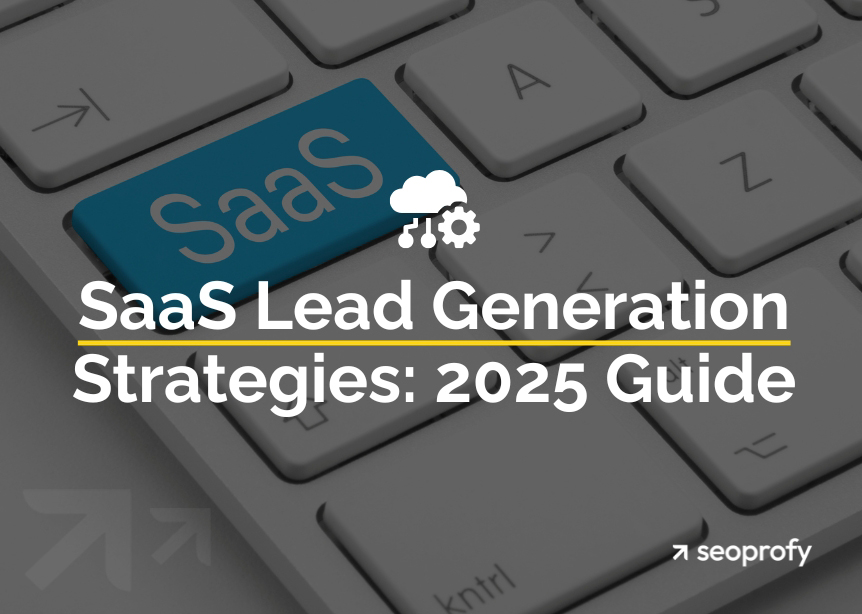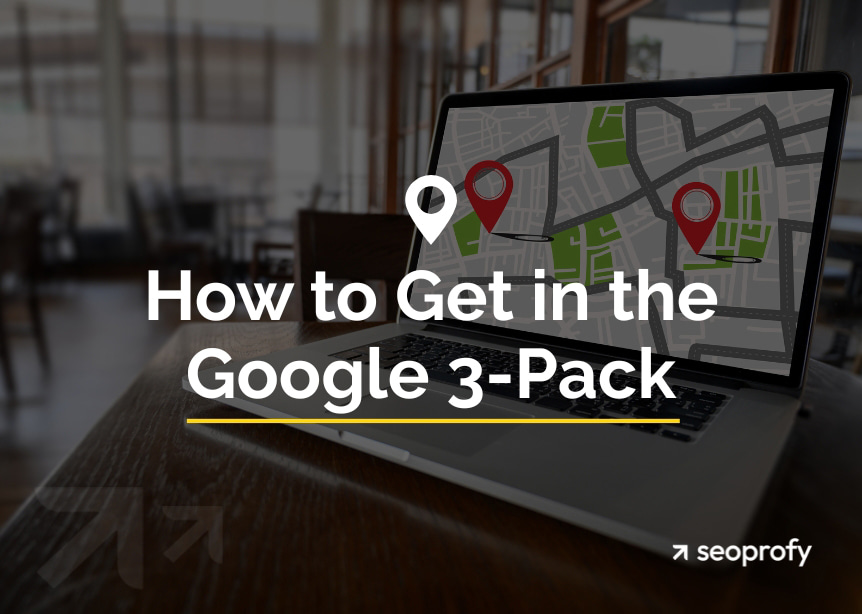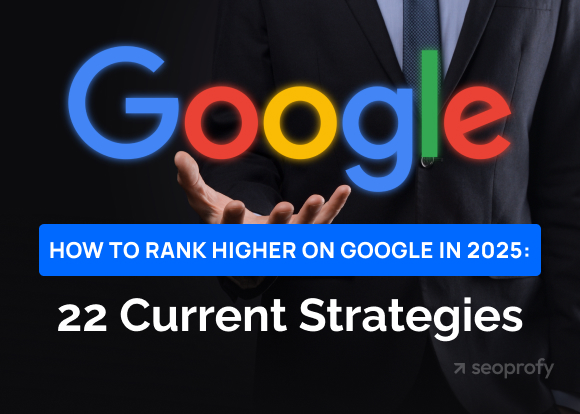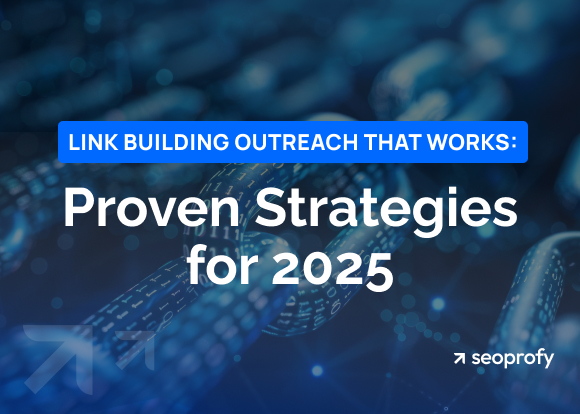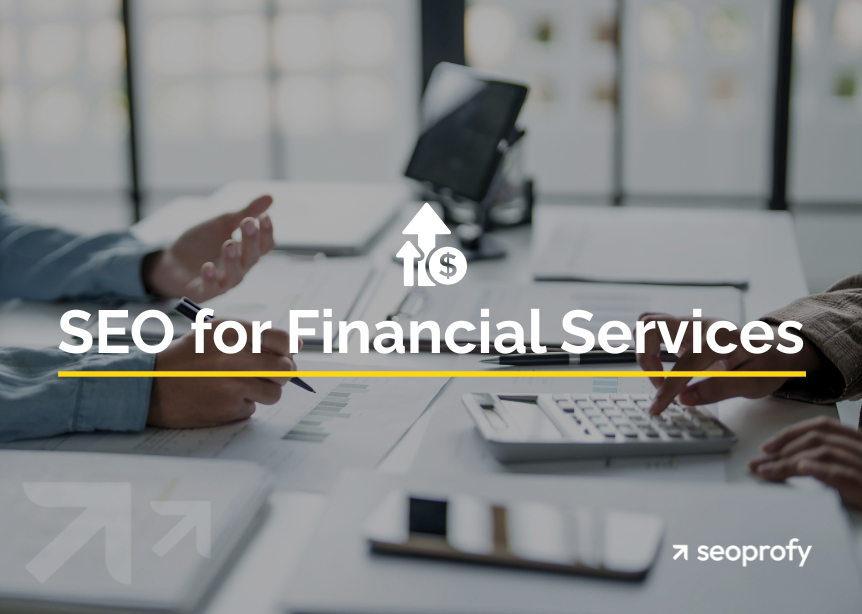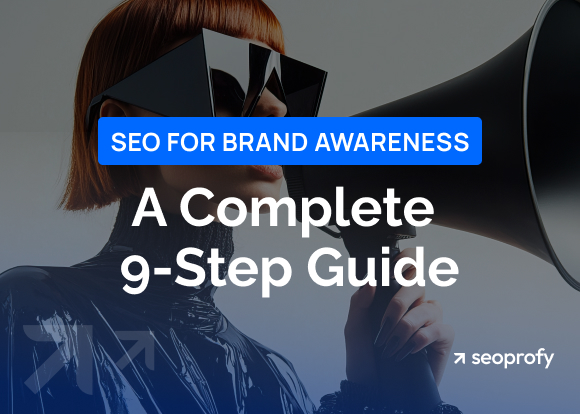Every journey needs a destination point, and the same goes for search engine optimization. Before you start an SEO campaign, take your time to set your desired targets.
A lack of clear SEO goals and objectives may lead to lost time plus money on approaches that don’t match your business requirements. This can also make you celebrate numbers that sound impressive in theory but eventually don’t move the needle for your company at all.
That’s exactly why SeoProfy begins each of our new projects with defining targets that result in actual business growth. In this article, we’ll share our experience on how to set SEO goals.
What Are SEO Goals and Why Do They Matter?
“We want to be more visible online, get more website visitors, and our conversion rate needs improvement.” These are common expectations businesses have when they start with SEO. Yet, they’re just too vague to make an actual impact.
What are SEO goals, then? They are specific and measurable targets that outline exactly what you want to achieve with your website’s search engine optimization.
Here are a few examples of actionable SEO goals:
- Get 40 solid backlinks from reputable websites (DA 75+) within a specified timeframe
- Grow monthly organic visitors from 25,000 to 45,000 by the end of Q3, with a focus on commercial pages
- Improve the organic traffic conversion rate from 1.8% to 3.5% by optimizing product pages and the checkout process
When your goals are this specific, this simplifies SEO planning and makes it easier to reach them. Plus, it becomes much simpler to track your progress since you won’t be wondering whether your SEO is working. You’ll see exactly how close you are to achieving that 3.5% conversion rate.
Most importantly, the clarity in numbers makes budgeting and other resource planning clearer. When you aim to get 40 backlinks, you can anticipate what it takes: writing guest posts, sending outreach emails, and possibly hiring link builders if your team can’t handle it alone. Plus, if you’re going to work with external specialists, once you’ve defined your SEO goals, you’ll better understand which questions to ask SEO company professionals about their expertise.
What Impacts an SEO Goal Setting?
SEO success depends on a lot of different factors. We’ve analyzed hundreds of SEO campaigns, and here’s the core conclusion we’ve made: the most efficient strategies are built around each business’s unique situation, not only general industry standards or competitor achievements.
Let’s discover what factors will shape your SEO goals.
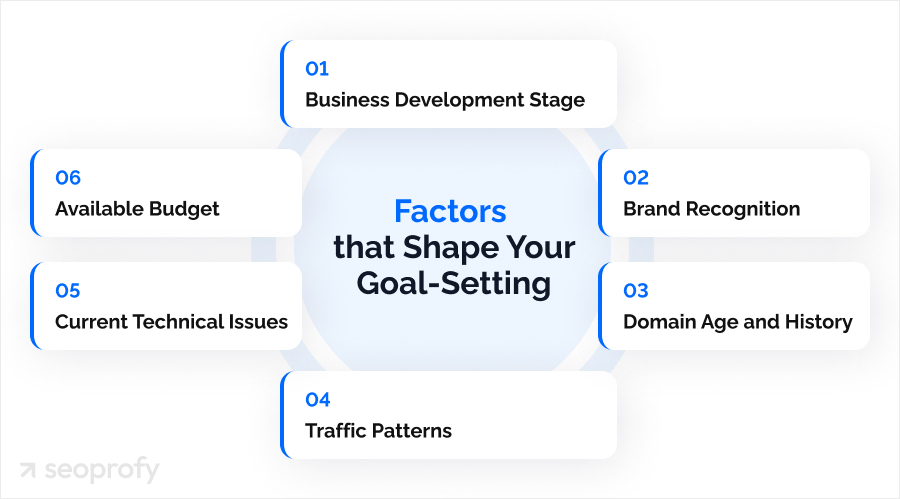
Business Development Stage
The stage your business is in plays a big role in the direction you need to take. When it comes to newer companies, success here often comes from targeting less competitive keywords and gradually increasing the domain authority score with each page.
Meanwhile, if your business is established, you can already aim higher. You might try to rank for high-value terms while also ranking for 100 new competitive keywords. The longer you’ve been on the market, the bolder your ranking objectives can get.
Brand Recognition
The recognition of your brand has a huge impact on what SEO goals are actually doable. Well-known brands can shoot for the stars with targets, like ranking for high-competition keywords or doubling their organic traffic on commercial pages.
If your brand is not yet well-known, set more modest goals. Focus on ranking for specific industry-related problems instead of broad terms. Build authority on niche topics first, then gradually expand your reach.
Domain Age and History
Domain age and history affect your goal setting in terms of SEO results time frame. SeoProfy uses its proprietary SearchAnalytics tool to assess how quickly you can expect results from your SEO efforts based on your domain age.
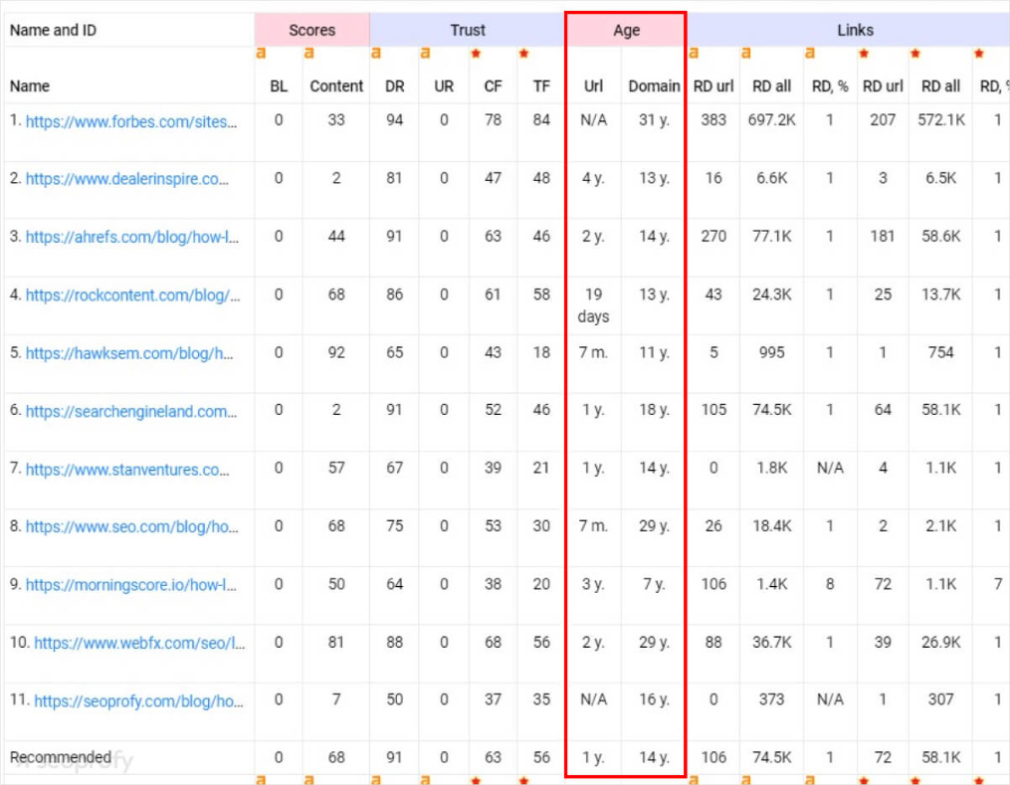
The more historical data, like content and backlinks, you have, the faster you can achieve your targets due to an established baseline and web authority. This allows you to improve rankings for current keywords and explore new topics.
New domains require patience to build credibility with Google. Start by creating a strong content base and targeting less competitive long-tail keywords before moving to higher-value ones.
Traffic Patterns
Consistent traffic growth indicates your SEO is effective, allowing you to build on your success. If traffic declines, identify the cause. Issues may range from technical problems like slow speeds or indexing errors to content issues like outdated data or keyword cannibalization. Prioritize diagnosing and resolving these problems.
Current Technical Issues
Speaking of technical issues, they’re particularly critical since they can prevent both users and search engines from reaching your content. Take Vodafone’s success story. Optimizing the loading speed of the largest content elements on their landing page let them increase their sales by 8%.
Thus, if your website has serious issues, start by addressing them. Only after you’ve tackled these challenges can you set more aggressive targets.
Available Budget
Last but definitely not least, your budget. It determines what company objectives are realistic in the first place. A larger budget lets you chase multiple SEO objectives at once. Consider this example of SEO goals: fixing technical issues while creating fresh content and building backlinks. But if your resources are tight, you need to keep your goals more focused, involving local SEO or perhaps aiming to dominate one specific niche before moving on to others.
The budget factor particularly impacts keywords that are more feasible to target. Suppose you’re selling a CRM product. Check out the picture below:
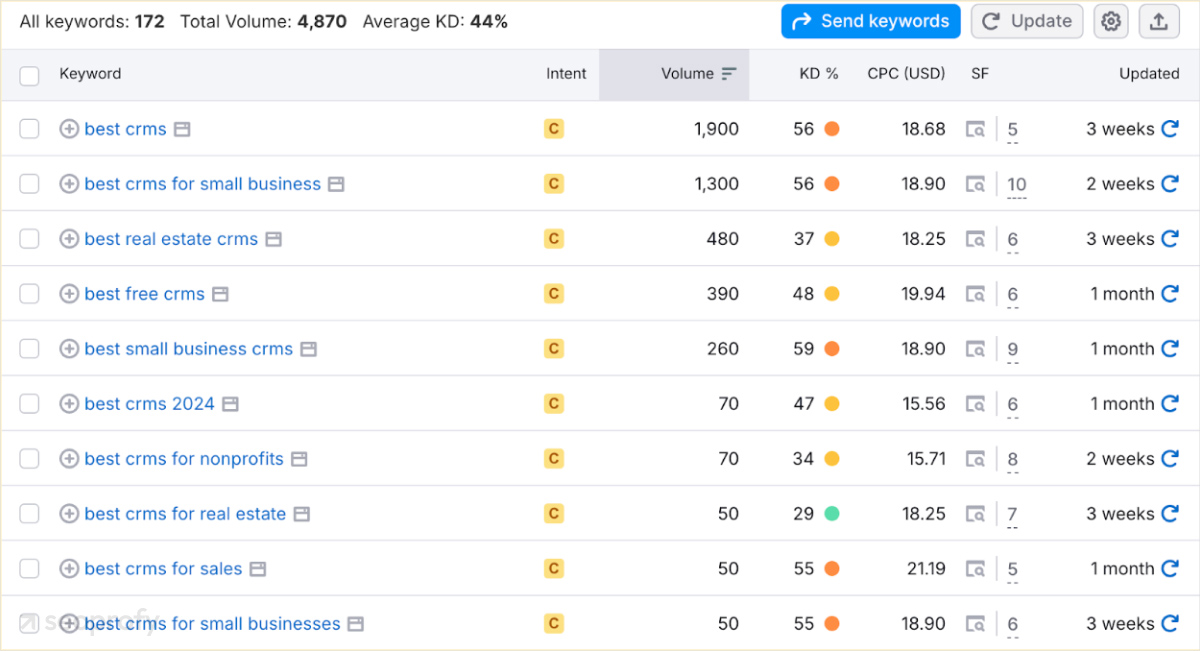
The keywords “best CRMs” and “best CRMs for small business” have high search volumes (1,900 and 1,300) but are more competitive (difficulty 56%), requiring more SEO effort and budget.
For a limited budget, it’s smarter to target specific, lower-difficulty keywords like “best real estate CRMs” or “best free CRMs.” Though they have fewer searches, they are easier and cheaper to rank for while effectively driving conversions by addressing specific needs.
Let’s turn your SEO vision into measurable results. Our professional team will help you to:
- Set long-term SEO goals
- Prepare a well-rounded SEO strategy
- Improve your search positions
- Boost website traffic and conversions
- Increase brand awareness

How to Set Realistic SEO Goals?
So, the road to top positions is about setting realistic SEO goals. But here’s the catch: it can be challenging to understand the difference between measurable goals that boost your growth and those that are just pipe dreams that lead to constant dissatisfaction. Here are six tips to help you find a balance in your goal setting.
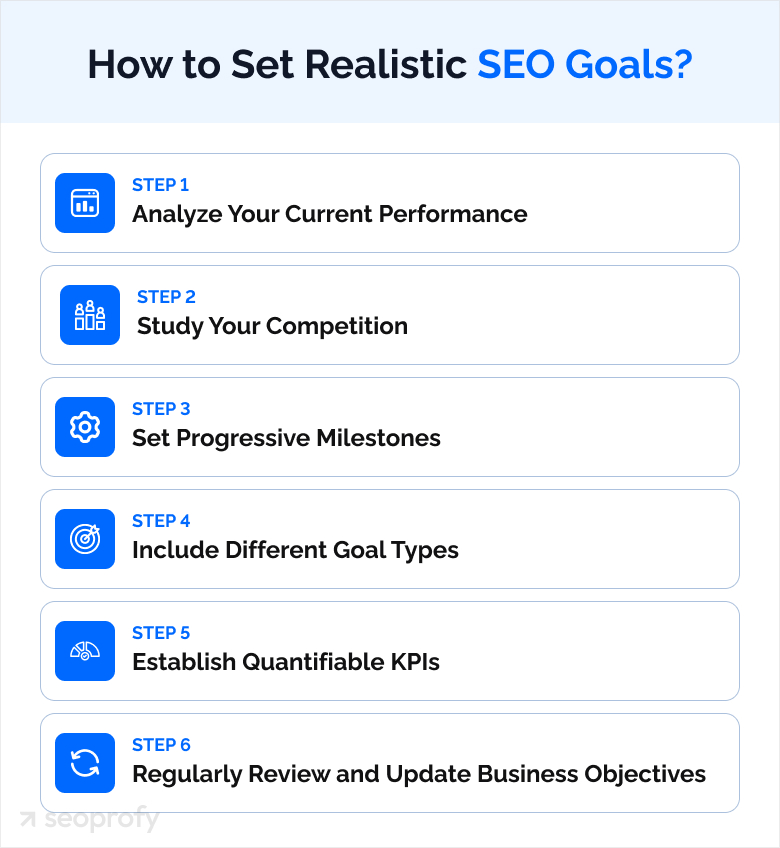
Analyze Your Current Performance
As we mentioned earlier, your starting point depends on several variables. First of all, evaluate your current keyword rankings, organic traffic growth, and conversion rates. This is how you can confirm what’s working and what isn’t.
For example, certain keywords may bring highly engaged visitors, or specific content types are more beneficial than others. Without analysis of your current state, there’s the risk that golden opportunities will remain hidden.
Study Your Competition
Next, spend some time doing competitor research. And this relates not just to the businesses in your niche. Pay attention to everyone ranking for your target keywords.
For example, in healthcare SEO, you might find yourself up against big names like PubMed and Mayo Clinic — the kinds of authoritative sources Google loves. Just type in “heart disease symptoms” in Google, and you’ll see what we mean — the first organic result belongs to Mayo Clinic:
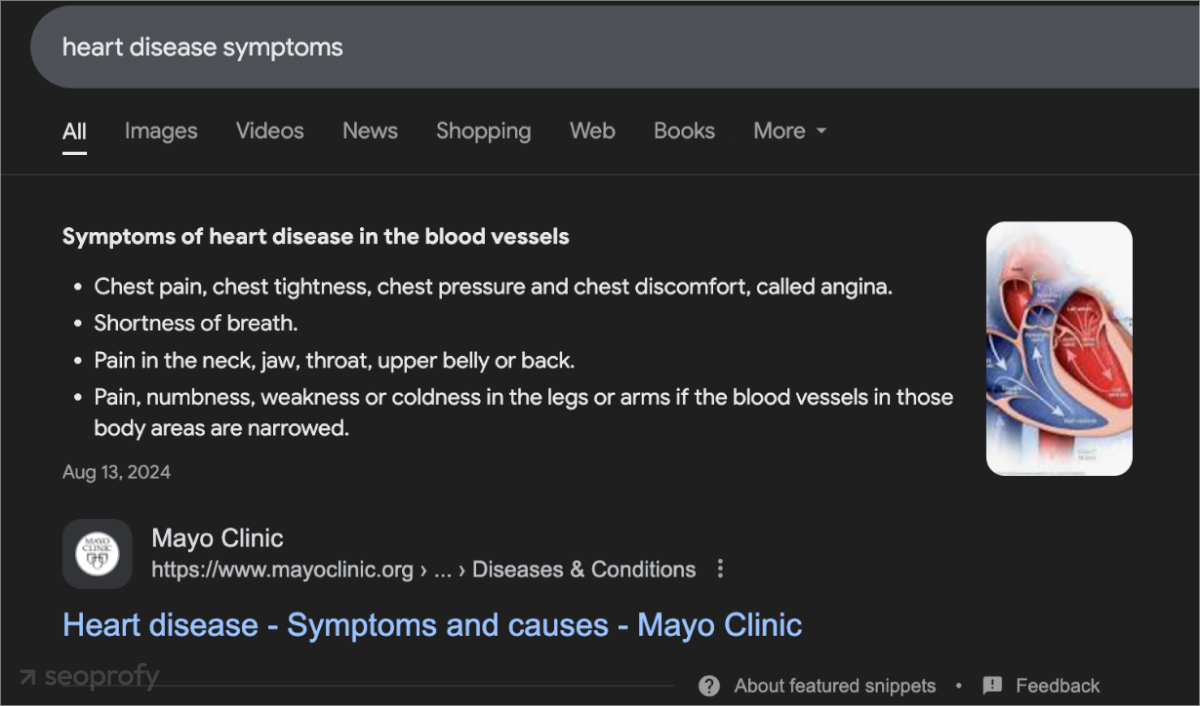
Set Progressive Milestones
What is the most common SEO mistake we see? Setting one big target without mapping out the path to get there. Structure your strategy like a goal pyramid, where each level supports the ones above it, and you may see that the impossible can actually be quite possible.
“Dominate all our keywords by Q4″ sounds pretty scary, right? To reduce frustration, you could rather decide to improve rankings for five specific long-tail keywords. Once you achieve this milestone, you can target slightly more competitive terms.
Include Different Goal Types
SEO isn’t just about rankings—traffic must convert, and content should resonate with your audience. A strong strategy balances goals like content performance to drive engagement and reduce bounce rates, technical SEO to ensure fast loading and error-free indexing, and brand visibility to expand impressions and search presence.
Focusing on these ensures traffic translates into real results.
Establish Quantifiable KPIs
You’ve probably come across ads like, We’ll get you to #1 in 6 months!” Here’s the deal: any SEO company promising guaranteed SEO results is either clueless or trying to mislead you on purpose. Google’s algorithms are always changing and use hundreds of factors, so exact predictions are out of the question.
Therefore, avoid such hollow promises; focus on measurable KPIs that impact your business instead.
Here are the key metrics our data-driven SEO agency tracks:
- Keywords in the top 10: How many of your target keywords reach the first page of Google? It’s critical because most people hardly look beyond page one.
- The average position of keywords: This KPI tracks your overall ranking performance across all your targeted keywords. For example, jumping from position 15 to 8 can significantly increase your click-through rates and traffic.
- Targeted organic traffic: We’re not just talking about any traffic; there are visitors coming through the specific keywords. This tells you if you’re attracting an audience that’s genuinely interested in what you offer.
- Number of leads or conversions: This is the ultimate measure of SEO success — how many visitors take the actions you want, like buying or signing up. This metric connects your SEO efforts to the desired outcome.
What gets measured gets improved, and KPIs are what can assist you in driving business results.
Regularly Review and Update Business Objectives
SEO is a dynamic process that requires constant adjustment. Market conditions change, competitors become stronger, and Google updates its algorithm. This is why we recommend doing weekly check-ins to monitor your SEO progress.
Take into account both overperformance and underperformance. If certain keywords rank faster than expected, you might allocate more resources to this area to strengthen your strategy further. If conversion rates aren’t improving despite higher rankings, it might be time to set some new SEO performance goals around content quality or user experience.
8 Common SEO Goals and Objectives
And here we’re getting down to the main business — the actual goals you can consider including in your SEO strategy this year. In this section, we’ll mention both smaller objectives that help set you up for bigger wins and strategic targets, like an increased number of qualified leads or conversions.
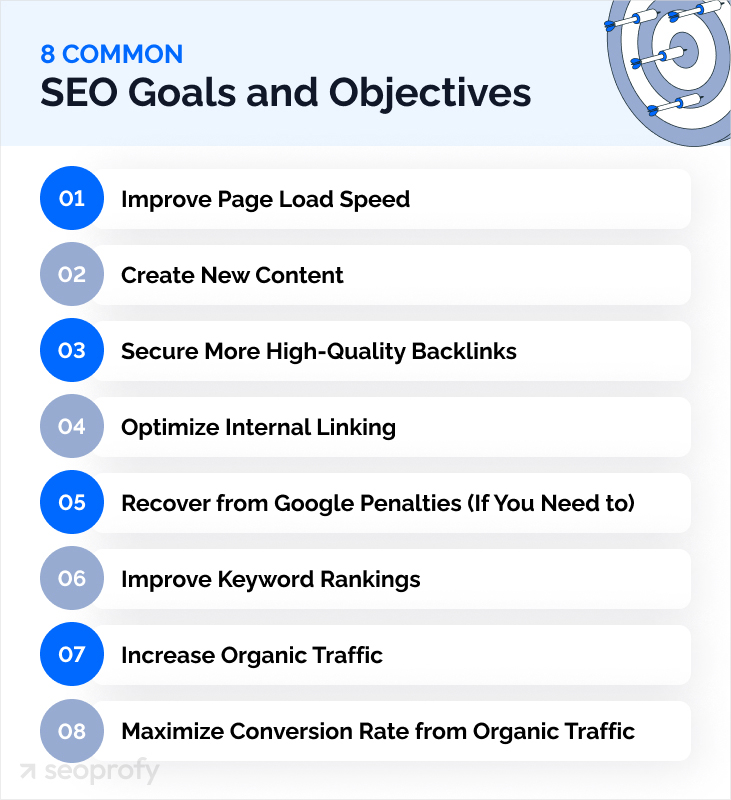
Improve Page Load Speed
Technical SEO needs to be a primary goal to reach. If people can’t access your page or it takes forever to load, then nothing else matters.
Google’s Core Web Vitals (three specific measurements that show how user-friendly your website is) confirm that speed isn’t just about quick initial loading. You need to consider:
- Largest contentful paint (LCP): How quickly the main content of your page becomes visible. Imagine opening a web page — how long does it take for the largest image or text block to appear? Google wants this to happen within 2.5 seconds.
- Interaction to Next Paint (INP): How quickly your website responds to user actions like clicks and taps. In other words, how long visitors have to wait after they interact with something on your page. A good INP score is under 200 milliseconds, or a fifth of a second.
- Cumulative layout shift (CLS): How much your page elements move around while loading. Ever tried to click something, but the page shifted and you hit the wrong button? That’s exactly what CLS measures. Lower scores (under 0.1) mean your page loads smoothly and avoids those annoying misclicks.
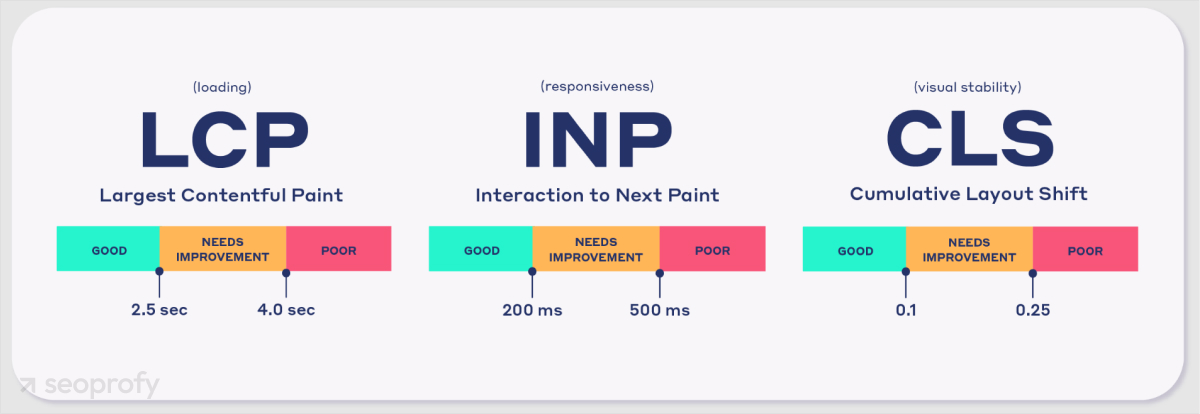
You can use Google’s PageSpeed Insights to keep track of these numbers. It gives you current performance data plus specific tips for making these parameters better.
Create New Content
Content serves multiple purposes in your strategy, and each type helps you achieve different SEO goals. Informational content, like expert articles, attracts people at the awareness stage of the marketing funnel (we can also call them window shoppers). Helpful content builds trust before website visitors are ready to buy and, thus, addresses your brand visibility objectives.
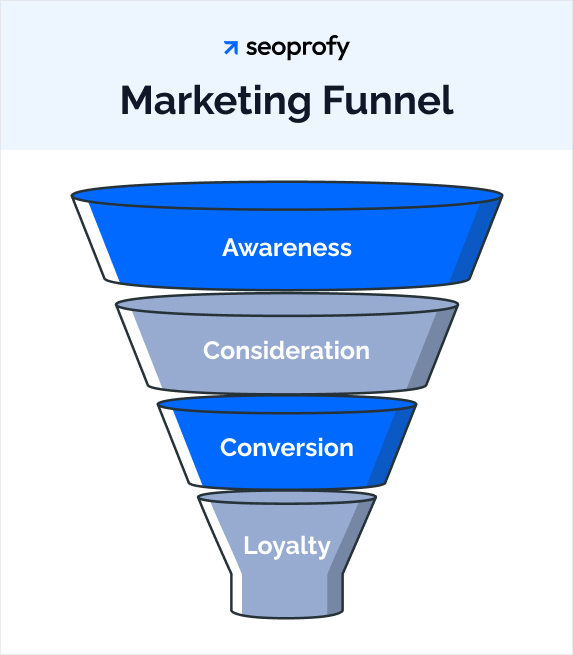
Commercial content, such as landing pages and case studies, is primarily designed to drive sales. Its primary goal is to answer the critical question, “Why should customers choose you?” This type of content plays a pivotal role in achieving your conversion objectives.
To maximize effectiveness, all content must adhere to Google’s E-E-A-T (Experience, Expertise, Authoritativeness, and Trustworthiness) guidelines. Demonstrating these qualities is essential for building credibility and trust with both users and search engines. Overlooking E-E-A-T can significantly hinder your ability to achieve your traffic and conversion goals.
For topic selection, tools like Ahrefs and Semrush are invaluable in identifying high-impact opportunities. To monitor the performance of your digital marketing strategy, platforms such as Google Analytics and Search Console provide critical insights, helping refine and optimize your efforts.
Secure More High-Quality Backlinks
Backlinks are still one of Google’s top-ranking signals, and for a good reason — they show that other websites consider your content to be worth referencing. But backlinks help with multiple SEO goals beyond just rankings:
- Building authority: When leaders in your industry link to your content, it boosts your domain authority. This makes it easier to rank for competitive keywords across your whole website, not just the pages that have links.
- Driving referral traffic: Quality backlinks from relevant sites bring focused visitors. When an industry blog links to your detailed guide, you’re getting readers who are already interested in your topic, and this makes them more likely to convert.
- Increasing brand visibility: Each backlink is another chance for new audiences to find out about your brand. When trusted sources mention your research or quote your experts, it builds your credibility with potential customers.
Here, you’ll also benefit from tools like Ahrefs or SEMrush. They can monitor your link profile growth, analyze competitors’ efforts, and alert you when you gain or lose links.
Optimize Internal Linking
While some websites tend to focus heavily on securing external links, internal linking can also assist you in getting more value from every page on your site and guide visitors and search engines to your most important content.
Here’s what SEO goals it supports:
- Better crawling and indexing: By linking to the important pages from your high-authority content, you guide search engines to understand your site’s layout and prioritize your best pages.
- Spreading ranking power: Some pages get more authority from backlinks or traffic. Good internal links help pass some of that power over to the pages you want to rank higher for competitive keywords.
- Supporting conversions: When someone checks out your informative content, relevant links to your services or products encourage them to take the next step. This eventually supports your strategic goals.
Check out tools like Link Whisper for automatic tips or Screaming Frog to analyze your link patterns and spot any orphaned pages (pages that have no internal links pointing to them from anywhere else on your site).
Recover from Google Penalties (If You Need to)
Sometimes, your SEO efforts hit an unexpected roadblock — a Google penalty. Penalties can seriously impact your website’s performance, whether it’s a manual action notice in the Search Console or a sudden traffic drop after an algorithm update (you can confirm this on the Google Search Status Dashboard).
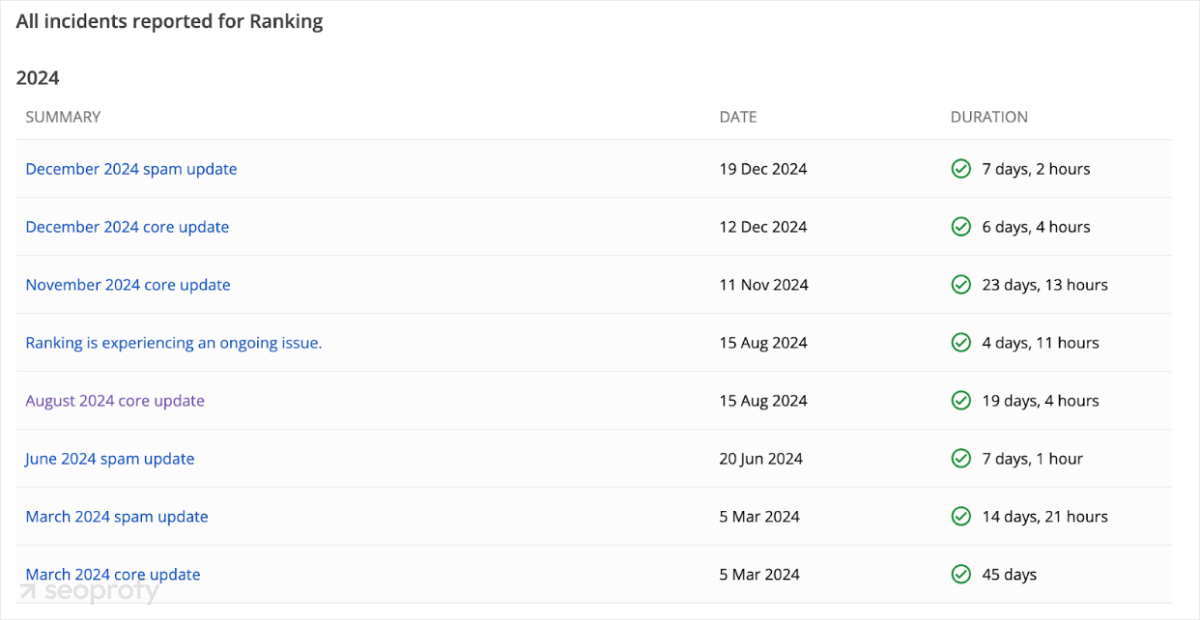
Your recovery goals, just like any goals, should be specific. Here are some milestone examples:
- Audit all backlinks and remove spammy ones
- Find and fix or delete all thin content pages (pages that provide little to no unique value)
- Tackle keyword-stuffing issues in your product descriptions
- Address any technical problems that go against Google’s guidelines
Recovery takes time and patience. So, set realistic timelines and don’t expect instant success. Once your site is back on track, you can go ahead and aim for bigger goals, like the ones below. SeoProfy has proven expertise in site recovery after penalties. Check out this site recovery case to see how our strategies brought results in the automotive niche.
Improve Keyword Rankings
Higher positions in search engines for your key terms directly affect your site’s visibility and traffic. Setting clear SEO goals starts with figuring out your most valuable keywords — the search terms that bring the right visitors to your site. These usually include your product names, key features, common issues you solve for customers, and industry-specific lingo.
Consider these milestones when planning your ranking improvement strategy:
- Move from page 2 to page 1 for your primary keywords through content optimization and link building
- Achieve top 5 positions for at least 50% of your core keywords by creating comprehensive content that matches search intent
- Expand your keyword portfolio by 25% every quarter to capture more long-tail terms
Google Search Console provides legit ranking data straight from Google. This tool can show your average position and click-through rates for different queries. If you require more in-depth insights, Ahrefs and SEMrush must be your go-to options.
Increase Organic Traffic
High organic traffic is one of the most rewarding yet complex goals in SEO. Here, each content piece, keyword ranking, and other optimization efforts contribute to the number of website visitors.
However, organic traffic isn’t just about the numbers but also about quality. You should target people who actually see real value in your products or services. That’s what makes organic traffic so powerful — these visitors come with the intention to buy.
Break this goal into smaller steps to make it way more doable. For example:
- Grow monthly organic sessions by 20% quarter-over-quarter through content expansion and optimization of existing pages
- Boost organic conversion rate by 15% in the next quarter by aligning content more closely with search intent
- Expand organic traffic sources to include image search and featured snippets
To measure SEO performance, start by establishing your basic SEO metrics in Google Analytics: total organic sessions, pages per session, time on site, and bounce rate.
Maximize Conversion Rate from Organic Traffic
This is the ultimate measure of your SEO success. Rankings are great, traffic is essential, but conversions from organic visitors are what bring you profit and, thus, your ROI.
Let’s break this goal into milestones:
- Improve conversion rate from organic landing pages by enhancing relevance between search intent and page content
- Reduce the path to conversion by removing unnecessary steps at the checkout
- Achieve a 40% conversion rate for high-intent commercial keywords through targeted content and clearer calls to action
- Match mobile conversion rate to desktop performance through better mobile user experience
You can use tools like Google Analytics and your CRM to track the full journey from organic search to conversion. Pay special attention to:
- Time to the first conversion from organic entry
- Pages viewed before converting
- Exit points in your conversion funnel
- Conversion rate differences across devices
- Effect of content updates on conversion performance
A clearer headline, a more noticeable call-to-action, or a simpler form might be all it takes to turn casual browsers into buyers. Test these elements regularly to find what works for your audience.
Conclusion
SEO is an exciting journey, but it’s only rewarding when you know your exact destination. Establish SEO goals correctly, and you’ll be able to turn an overwhelming process into a series of manageable milestones.
Just remember to keep your goals SMART: specific, measurable, achievable, relevant, and time-bound. This way, you’ll speed up your success, save your budget on blind trial and error, and get the feeling of fulfillment as you celebrate small victories along the way.
Want to elevate your journey to SEO success? SeoProfy is an excellent goal-setter. Let’s talk about your SMART goals.




